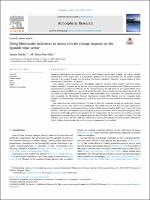Por favor, use este identificador para citar o enlazar este ítem:
https://repositorio.usj.es/handle/123456789/999
| Título : | Using bioclimatic indicators to assess climate change impacts on the Spanish wine sector |
| Autor: | Gaitán Fernández, Emma

Pino Otín, Rosa 

|
| Palabras clave : | Grapevine; Climate change; Spain; Impacts; CMIP5; Statistical downscaling |
| Fecha de publicación: | 27-feb-2023 |
| Citación : | Emma Gaitán, Mª. Rosa Pino-Otín, Using bioclimatic indicators to assess climate change impacts on the Spanish wine sector, Atmospheric Research, Volume 286, 2023, 106660, ISSN 0169-8095, https://doi.org/10.1016/j.atmosres.2023.106660. (https://www.sciencedirect.com/science/article/pii/S0169809523000571) |
| Resumen : | Grapevine cultivation is an ancestral practice in Mediterranean regions such as Spain. The current climatic characteristics of this region make it a particularly optimal area for its cultivation, and the climatic changes expected in the coming decades may jeopardise this climatic suitability. Therefore, accurate studies of future projections at a local level are essential. Local climate change scenarios of six bioclimatic indicators (absolute values together with their categorisation) related to vineyards for the Spanish region based on nine Earth System Models (ESMs) as well as two Representative Concentration Pathways (RCPs) corresponding to the fifth phase of the Coupled Model Intercomparison Project (CMIP5) were generated for the first time. These indicators are the Huglin Index (HI), the Cool Index (CI), the Dryness Index (DI) and the Hidrotermic Index. As a complement, two combined indicators were calculated: the Multicriteria Climatic Classification System (MCC System) and the Composite Index (CompI). The whole territory was analysed as well as the areas involved in the Spanish Denominations of Origin (DOs). Our results show that Thermal indicators (HI and CI) will tend to increase through the twenty-first century, while water scarcity (DI) will be more pronounced. The trends found do not have the same repercussions throughout the territory. In the south of the peninsula, with HI values exceeding 3500◦C and CI above 20◦C and DI below 200 mm, the continuity of the wine-growing sector in its current state is seriously endangered, with a decrease in climatically optimal years as shown by the CompI values. On the contrary, the northern peninsula and mountainous areas, despite the expected increases, with HI below 2500◦C, cool nights (CI below 15◦C) and sufficient water supply (DI above 150 mm) considerably improve their climatic suitability (CompI) although the risk of mildew disease remains due to the increase in temperature and humidity. |
| URI : | https://repositorio.usj.es/handle/123456789/999 |
| ISSN : | 0169-8095 |
| Aparece en las colecciones: | Artículos de revistas |
Ficheros en este ítem:
| Fichero | Descripción | Tamaño | Formato | |
|---|---|---|---|---|
| Using bioclimatic indicators to assess climate change impacts on the Spanish wine sector.pdf | 17,32 MB | Adobe PDF |  Visualizar/Abrir |
Este ítem está sujeto a una licencia Creative Commons Licencia Creative Commons

